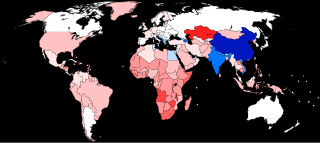
Human life expectancy is a statistical measure of the estimate of the average remaining years of life at a given age. The most commonly used measure is life expectancy at birth. This can be defined in two ways. Cohort LEB is the mean length of life of a birth cohort and can be computed only for cohorts born so long ago that all their members have died. Period LEB is the mean length of life of a hypothetical cohort assumed to be exposed, from birth through death, to the mortality rates observed at a given year. National LEB figures reported by national agencies and international organizations for human populations are estimates of period LEB.

Cardiovascular disease (CVD) is any disease involving the heart or blood vessels. CVDs constitute a class of diseases that includes: coronary artery diseases, heart failure, hypertensive heart disease, rheumatic heart disease, cardiomyopathy, arrhythmia, congenital heart disease, valvular heart disease, carditis, aortic aneurysms, peripheral artery disease, thromboembolic disease, and venous thrombosis.
The Whitehall Studies investigated social determinants of health, specifically the cardiovascular disease prevalence and mortality rates among British civil servants. The initial prospective cohort study, the Whitehall I Study, examined over 17,500 male civil servants between the ages of 20 and 64, and was conducted over a period of ten years, beginning in 1967. A second cohort study, the Whitehall II Study, was conducted from 1985 to 1988 and examined the health of 10,308 civil servants aged 35 to 55, of whom two thirds were men and one third women. A long-term follow-up of study subjects from the first two phases is ongoing.
The social determinants of health are the economic and social conditions that influence individual and group differences in health status. They are the health promoting factors found in one's living and working conditions, rather than individual risk factors that influence the risk or vulnerability for a disease or injury. The distribution of social determinants is often shaped by public policies that reflect prevailing political ideologies of the area.

In demography and medical geography, epidemiological transition is a theory which "describes changing population patterns in terms of fertility, life expectancy, mortality, and leading causes of death." For example, a phase of development marked by a sudden increase in population growth rates brought by improved food security and innovations in public health and medicine, can be followed by a re-leveling of population growth due to subsequent declines in fertility rates. Such a transition can account for the replacement of infectious diseases by chronic diseases over time due to increased life span as a result of improved health care and disease prevention. This theory was originally posited by Abdel Omran in 1971.

Men's health is a state of complete physical, mental, and social well-being, as experienced by men, and not merely the absence of disease. Differences in men's health compared to women's can be attributed to biological factors, behavioural factors, and social factors.

Allostatic load is "the wear and tear on the body" which accumulates as an individual is exposed to repeated or chronic stress. The term was coined by Bruce McEwen and Eliot Stellar in 1993. It represents the physiological consequences of chronic exposure to fluctuating or heightened neural or neuroendocrine response which results from repeated or prolonged chronic stress.

The Hispanic paradox is an epidemiological finding that Hispanic Americans tend to have health outcomes that "paradoxically" are comparable to, or in some cases better than, those of their U.S. non-Hispanic White counterparts, even though Hispanics have lower average income and education, higher rates of disability, as well as a higher incidence of various cardiovascular risk factors and metabolic diseases.

Healthcare in Europe is provided through a wide range of different systems run at individual national levels. Most European countries have a system of tightly regulated, competing private health insurance companies, with government subsidies available for citizens who cannot afford coverage. Many European countries offer their citizens a European Health Insurance Card which, on a reciprocal basis, provides insurance for emergency medical treatment insurance when visiting other participating European countries.

The human sex ratio is the ratio of males to females in a population in the context of anthropology and demography. In humans, the natural sex ratio at birth is slightly biased towards the male sex. It is estimated to be about 1.05 or 1.06 or within a narrow range from 1.03 to 1.06 males per female.
In 2006, life expectancy for males in Cyprus was 79 and for females 82 years. Infant mortality in 2002 was 5 per 1,000 live births, comparing favourably to most developed nations.
Research shows many health disparities among different racial and ethnic groups in the United States. Different outcomes in mental and physical health exist between all U.S. Census-recognized racial groups, but these differences stem from different historical and current factors, including genetics, socioeconomic factors, and racism. Research has demonstrated that numerous health care professionals show implicit bias in the way that they treat patients. Certain diseases have a higher prevalence among specific racial groups, and life expectancy also varies across groups.
The social determinants of health in poverty describe the factors that affect impoverished populations' health and health inequality. Inequalities in health stem from the conditions of people's lives, including living conditions, work environment, age, and other social factors, and how these affect people's ability to respond to illness. These conditions are also shaped by political, social, and economic structures. The majority of people around the globe do not meet their potential best health because of a "toxic combination of bad policies, economics, and politics". Daily living conditions work together with these structural drivers to result in the social determinants of health.

Indigenous health in Australia examines health and wellbeing indicators of Indigenous Australians compared with the rest of the population. Statistics indicate that Aboriginal Australians and Torres Strait Islanders are much less healthy than other Australians. Various government strategies have been put into place to try to remediate the problem; there has been some improvement in several areas, but statistics between Indigenous Australians and the rest of the Australian population still show unacceptable levels of difference.
The male-female health-survival paradox, also known as the morbidity-mortality paradox or gender paradox, is the phenomenon in which female humans experience more medical conditions and disability during their lives, but they unexpectedly live longer than males. This paradox, where females experience greater morbidity (diseases) but lower mortality (death) in comparison to males, is unusual since it is expected that experiencing disease increases the likelihood of death. However, in this case, the part of the population that experiences more disease and disability is the one that lives longer.
A disease of despair is one of three classes of behavior-related medical conditions that increase in groups of people who experience despair due to a sense that their long-term social and economic prospects are bleak. The three disease types are drug overdose, suicide, and alcoholic liver disease.
The COVID-19 pandemic has had an unequal impact on different racial and ethnic groups in the United States, resulting in new disparities of health outcomes as well as exacerbating existing health and economic disparities.
White Americans, as the largest racial group in the United States, have historically had better health outcomes than other oppressed racial groups in America. However, in recent years, the scholarly discourse has switched from recognition of the immense positive health outcomes of white Americans towards understanding the growing persistence of negative outcomes unique to this racial group. Scholars have discussed the effects of racial prejudice and its negative effect on health outcomes to not only those being oppressed but also those being given privileges. In addition to the effects of living in a racialized society, white Americans have the highest rate of suicide and lifetime psychiatric disorders of any other ethnicity or racial category. In conjunction with these psychiatric issues, the population presents higher rates of alcohol usage alongside lower levels of psychological flourishing. Given this information, the health status of white Americans has gained increasing importance due to the differences in health outcomes between white Americans and white people from other parts of the world.
Biological inequity, also known as biological inequality, refers to “systematic, unfair, and avoidable stress-related biological differences which increase risk of disease, observed between social groups of a population”. The term developed by Centric Lab aims to unify societal factors with the biological underpinnings of health inequities – the unfair and avoidable differences in health status and risks between social groups of a population - such that these inequalities can be investigated in a holistic manner.












